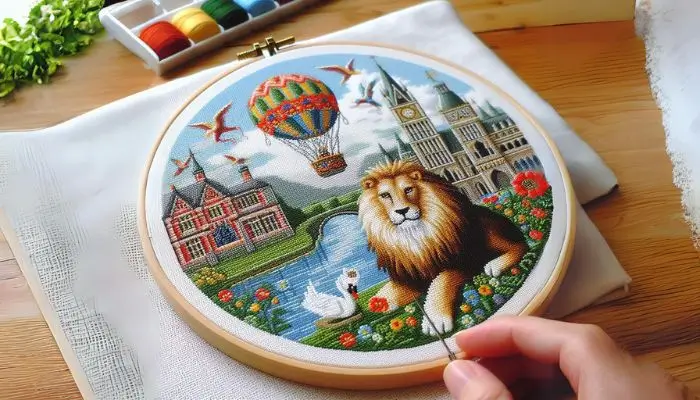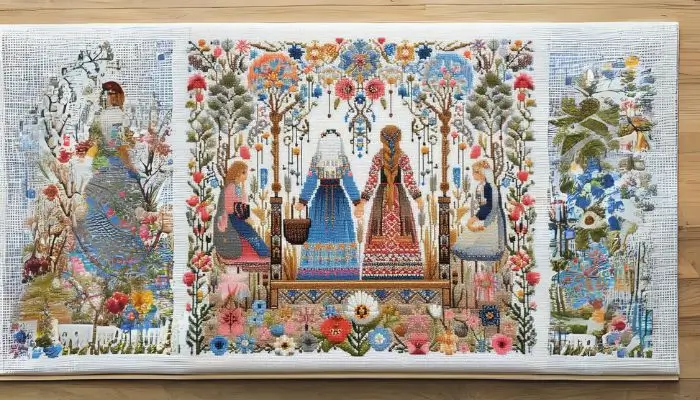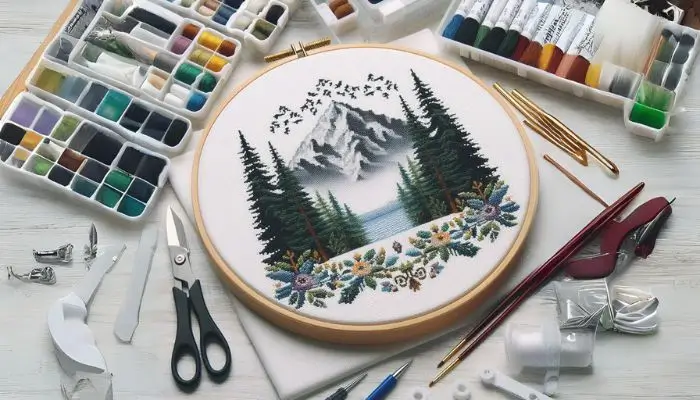Are you a passionate needlepoint enthusiast? After dedicating hours to your latest project, the finished piece might look a bit warped or misshapen. Don’t despair! Blocking is a simple yet transformative technique that can restore your needlepoint canvas to pristine condition. In this comprehensive guide, I’ll share expert tips and step-by-step instructions on how to block a needlepoint canvas – achieving a flawlessly squared and professional finish that showcases your beautiful craftsmanship.
Key Takeaways
- Blocking needlepoint is essential for a professional finish and squared-off edges.
- Choose between dry, wet, and steam blocking methods depending on your canvas and the degree of distortion.
- Careful pinning and gentle stretching are key to successful blocking.
Introduction
Needlepoint is a beautiful art form that results in intricate and textured pieces. However, after hours of dedicated stitching, your canvas may come off the frame slightly warped or distorted. Blocking is a simple yet crucial finishing step that reshapes your needlepoint canvas, giving it a polished appearance and ensuring the stitches lay flat.
What You’ll Need: Tools and Materials
Before you begin, gather the following supplies:
- Blocking Board: A flat, sturdy surface designed for blocking projects. Foam boards are affordable, while gridded boards offer precise alignment. You can find these at craft stores or online.
- T-Pins or Rust-Proof Pushpins: Essential for securing the canvas to the blocking board. Ensure they are rust-proof to prevent staining your needlework.
- Steamer or Iron with Steam Setting: Used to relax the fibers and make the canvas more pliable.
- Spray Bottle: For lightly dampening the canvas in wet or steam blocking methods.
- Optional: Ruler or Square: To check the alignment of your canvas during the blocking process.
Methods for Blocking Needlepoint Canvas
There are three main methods for blocking a needlepoint canvas – Let’s take a closer look at each:

Dry Blocking
This is the simplest method, ideal for canvases with minimal distortion.
- Pin and Align: Carefully pin your canvas to the blocking board, ensuring straight edges and using a ruler or square for accuracy.
- Dry Completely: Let the canvas dry fully before removing the pins.
Wet Blocking
Suitable for slightly more distorted canvases that need extra reshaping.
- Dampen the Canvas: Lightly spray the back of the canvas with water. Avoid over-wetting.
- Let it Rest: Allow the canvas to rest for a few minutes to absorb moisture.
- Pin and Stretch: Carefully pin and stretch the canvas on the blocking board as it dries.
Steam Blocking
Ideal for stubborn distortions and canvases made with natural fibers.
- Steam the Canvas: Use a steamer or iron on the back of the canvas without direct contact.
- Stretch and Pin Gently: While still slightly damp, stretch and pin the canvas to the blocking board.
- Dry Completely: Allow the canvas to dry fully before removing the pins.
Table: Choosing the Right Blocking Method
| Factor | Dry Blocking | Wet Blocking | Steam Blocking |
|---|---|---|---|
| Distortion | Minimal | Moderate | Stubborn |
| Fiber Type | All | Most | Especially natural fibers (wool, cotton, etc.) |
| Simplicity | Simplest method | Slightly more involved | Requires careful handling of steam |
How to Block a Needlepoint Canvas: Step-by-Step Guide
Now that you understand the different methods, let’s go through the general steps of blocking:

- Prepare your workspace: Lay down your blocking board on a flat, stable surface.
- Remove canvas from the frame: If you’ve used a frame while stitching, carefully remove your needlepoint canvas.
- Choose your method: Decide on the best method (dry, wet, or steam) based on the level of distortion and your canvas material.
- Dampen the canvas (if needed): For wet or steam blocking, gently dampen the canvas as described in the methods above.
- Pin and stretch: Begin pinning the canvas to the board, starting from the center and working outward. Stretch gently to ensure straight lines and use a ruler or square for alignment.
- Dry completely: This is crucial! Allow the canvas to dry entirely before removing the pins. This could take several hours to a full day.
Troubleshooting Tips
Even with careful planning, sometimes things don’t go quite as expected during blocking. Here are some common issues and how to address them:
- Stubborn Distortions: If your canvas remains distorted after the initial blocking, repeat the process with a wet or steam method for more intensive reshaping.
- Overstretching: If you notice your canvas is too taut while drying, remove some pins and allow it to relax slightly. Overstretching can damage the fibers.
- Rust Stains: Always use rust-proof pins! If rust stains do occur, try a specialized rust stain remover formulated for fabrics.
What is a needlepoint blocking board?
A needlepoint blocking board is a specialized surface, often made of foam or featuring a grid, designed for pinning and reshaping needlepoint canvases.
Where to buy a needlepoint blocking board?
You can find needlepoint blocking boards at craft stores, needlework specialty shops, and online retailers like Amazon or Etsy.
What is dry blocking needlepoint?
Dry blocking is the simplest needlepoint blocking method, ideal for canvases with minimal distortion. It involves pinning the canvas to a blocking board and allowing it to dry completely.
How to block crochet tapestry?
The techniques for blocking crochet tapestry are very similar to needlepoint blocking. Choose dry, wet, or steam blocking methods based on the material and the level of distortion.
How to frame needlepoint?
Framing a needlepoint piece typically involves mounting the blocked canvas onto a backing board and carefully placing it within a chosen frame. Professional framing services are also available.
What is needlepoint relaxant spray?
Needlepoint relaxant spray is a product used to slightly dampen and soften fibers before blocking, making the canvas more pliable and easier to reshape.
Additional Tips and Considerations
- Blocking Multiple Pieces: Batch block smaller needlepoint projects on a single board to save time.
- Alternative to a Blocking Board: In a pinch, a clean cork bulletin board or thick piece of cardboard can work as a temporary blocking surface.
- Creative Uses: Blocking boards are versatile tools that can also be used for blocking cross-stitch, embroidery, knitting, or crochet pieces.
FAQs on Needlepoint Blocking
Let’s address some common questions about needlepoint blocking:
How long should I leave my needlepoint canvas to dry?
Drying time depends on the blocking method and humidity levels. Generally, expect it to take several hours or even overnight to dry completely.
Can I block needlepoint made with acrylic yarn?
Yes, but heat can affect acrylic. Use the dry or wet blocking methods and avoid excessive steam.
Can I block needlepoint directly on my ironing board?
While possible, a specialized blocking board offers better support and, if gridded, helps with precise alignment.
How do you block needlepoint to frame?
Blocking your needlepoint canvas before framing is crucial for a squared and professional appearance. Choose the appropriate blocking method (dry, wet, or steam) based on your canvas’s distortion. Once dry, your needlepoint can be mounted and framed.
How do you secure a needlepoint canvas?
Here are common methods:
Blocking: Reshapes and aligns the canvas to prepare it for finishing.
Framing: Mounting it within a frame provides support and a finished look.
Lacing: Tightly stitching the canvas to a backing board offers stability.
How do you finish the edges of a needlepoint canvas?
Several options exist:
Simple Folding: Fold excess canvas to the back and secure with stitching.
Binding: Decorative fabric edging for a clean look.
Whipping: Wrapping thread around the canvas edges for protection.
